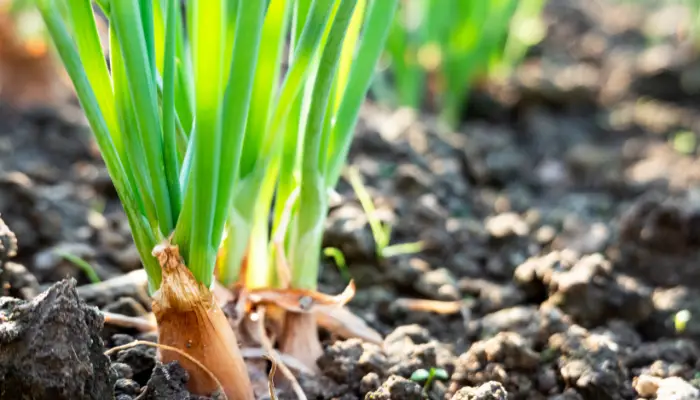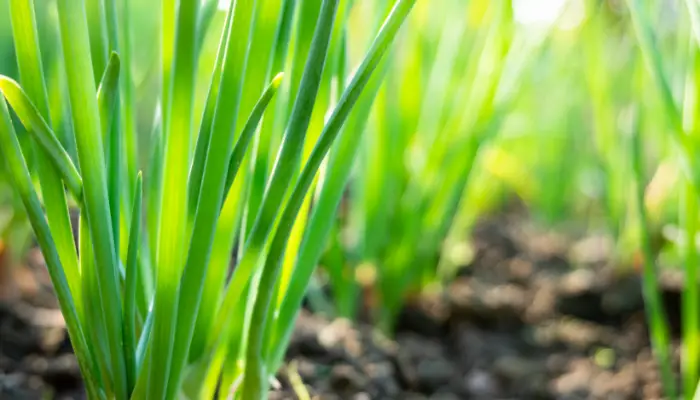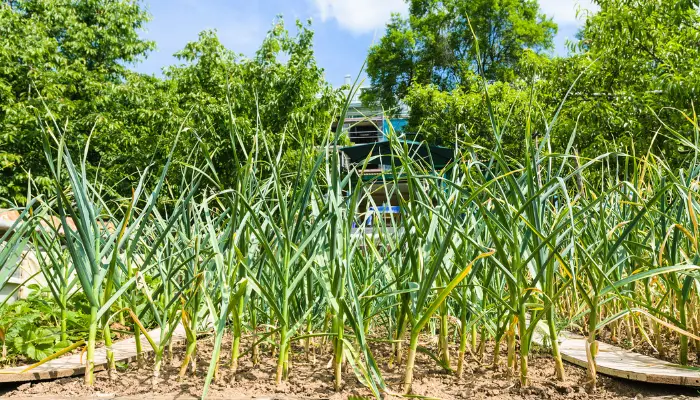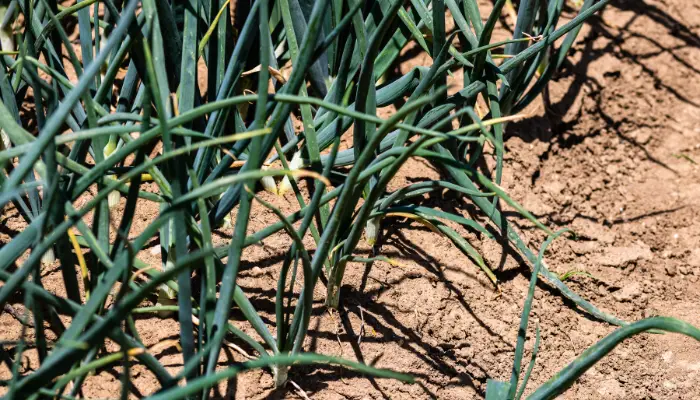Few ingredients in the wide world of culinary delights can match the freshness and adaptability of scallions, sometimes referred to as green onions or spring onions.
Their vivid green color and mild onion flavor make them a common ingredient in kitchens all around the world.
Scallions can be found easily in grocery shops, but growing them at home adds a unique touch to food preparation by giving you a direct link to the growing process.
We will go into cultivating scallions, ensuring a bountiful harvest that satisfies both the discerning gardener and the culinary enthusiast.
Choosing the Right Variety of Scallions

Varieties such as ‘Evergreen’ and ‘White Lisbon’ are favored among home gardeners for their adaptability, disease resistance, and exceptional flavor profile. When making your selection, consider factors like climate, soil type, and the available gardening space to ensure optimal growth.
Site Selection and Soil Preparation
Creating a conducive environment for scallion growth begins with choosing the right location. Select a sunny spot that receives a minimum of 6-8 hours of sunlight per day.
Scallions thrive in well-drained, fertile soil with a slightly acidic to neutral pH (6.0-7.0). Begin soil preparation by removing weeds and debris, and then enrich the soil with organic matter such as compost to enhance fertility and improve its structure.
Since scallions prefer well-draining soil, taking measures to prevent waterlogging is crucial in avoiding potential root rot issues.
Planting Scallion Seeds

How To Grow Scallions
The journey of scallion cultivation can begin either from seeds or sets.
For those starting from seeds, sow them directly in the garden or initiate the process indoors 8-10 weeks prior to the last expected frost. Plant the seeds approximately 1/4 inch deep in rows spaced 12-18 inches apart.
Once the seedlings reach a height of 2-3 inches, thin them to a spacing of 2 inches to allow for unhindered growth.
Alternatively, if you opt for sets, plant them about 1 inch deep with 3-4 inches of space between each set.
Sets offer a convenient way for beginners to kickstart the growing process, providing a head start in development.
Watering and Fertilizing

Consistent and adequate watering is essential to foster healthy scallion growth.
Maintain a soil moisture level that keeps the ground consistently moist, particularly during dry spells.
However, exercise caution to prevent overwatering, as scallions are susceptible to rot in excessively damp conditions.
Once the scallions reach a height of 4-6 inches, introduce a balanced, all-purpose fertilizer to the soil, following the recommended application rates on the packaging.
Periodic light side-dressings of a nitrogen-rich fertilizer every 3-4 weeks can further promote vigorous growth.
Managing Weeds and Pests
The path to a thriving scallion crop involves vigilant weed management.
Weeds not only compete for essential nutrients and water but also serve as hiding places for pests.
Applying a layer of organic mulch around scallion plants can effectively suppress weeds while retaining soil moisture.
Keep a watchful eye for common pests such as aphids, thrips, and onion maggots.
Combatting these pests can be achieved through the application of insecticidal soap or neem oil.
Additionally, practicing crop rotation helps reduce the risk of onion maggot infestations.
Cultural Practices for Optimal Growth
Ensuring the optimal development of scallions involves adopting specific cultural practices that contribute to their overall well-being:
- Thinning: Regular thinning is imperative to provide adequate space for each scallion to thrive. Maintain the recommended spacing, usually 2 inches for seedlings and 4-6 inches for sets.
- Hilling: As the scallions grow, gently hill soil around the base of the plants. This process not only enhances the appearance of the scallions but also contributes to improved flavor by reducing bitterness.
- Harvesting Outer Leaves: To achieve a continuous harvest, selectively pluck outer leaves once they attain a length of 6-8 inches. This practice encourages the development of new leaves, extending the overall harvesting period.
Harvesting and Storage
Acquiring the knowledge of when and how to harvest scallions is pivotal in preserving their flavor and quality.
Harvest scallions when the green tops reach the desired length, typically 6-8 inches. Utilize a sharp knife or scissors to cut the leaves just above the soil level.
For prolonged storage, store harvested scallions in the refrigerator. An alternative preservation method involves freezing chopped scallions in sealed plastic bags, ensuring a convenient supply for future use in cooked dishes.
Summary
Growing scallions is more than just gardening; it’s an enjoyable experience that leaves people with a savory and novel addition to their recipe book.
Growing scallions can be a rewarding experience for any level of gardener, since it improves both your kitchen and garden.
So, get some gardening tools and some zeal, and set out to grow the best scallions you’ve ever seen, raising the bar on your culinary explorations.
Frequently Asked Questions (FAQs):
- Q: Can I grow scallions indoors?A: Yes, you can grow scallions indoors. Start seeds in pots or containers, providing ample sunlight or using artificial grow lights. Ensure the containers have proper drainage, and use a well-draining potting mix.
- Q: How long does it take for scallions to grow from seeds?A: Scallions typically take about 60-90 days from seed to harvest. Factors such as temperature, sunlight, and soil conditions can affect the growth rate.
- Q: Can I regrow scallions from kitchen scraps?A: Yes, you can regrow scallions from kitchen scraps. Place the white roots in water or soil, and they will regrow new green shoots. However, for sustained growth and flavor, it’s advisable to replant in soil after a few regrowth cycles.
- Q: How do I know when scallions are ready to harvest?A: Harvest scallions when the green tops reach 6-8 inches in length. Use a sharp knife or scissors to cut the leaves just above the soil level. Harvesting outer leaves allows for a continuous harvest.
- Q: Can I freeze scallions for later use?A: Yes, you can freeze scallions for later use. Chop them into desired lengths, place them in sealed plastic bags, and store in the freezer. While frozen scallions may lose some crispness, they remain suitable for use in cooked dishes.
- Q: How do I prevent pests in my scallion garden?A: Regularly inspect your scallion plants for pests like aphids, thrips, and onion maggots. Use insecticidal soap or neem oil to control aphids and thrips. Practicing crop rotation can help reduce the risk of onion maggot infestations.
- Q: What is the ideal spacing for planting scallions?A: For seedlings, maintain a spacing of 2 inches once they reach a height of 2-3 inches. For sets, plant them about 4-6 inches apart. Adequate spacing ensures proper air circulation and room for growth.
- Q: How often should I fertilize scallions?A: Fertilize scallions when they reach a height of 4-6 inches, using a balanced, all-purpose fertilizer. Follow the recommended application rates on the fertilizer package. A light side-dressing of nitrogen-rich fertilizer every 3-4 weeks can further support growth.
- Q: Can scallions be grown year-round?A: Scallions are cool-season crops and can be grown year-round in temperate climates. In warmer regions, they thrive in the cooler seasons of spring and fall. In colder climates, they can be grown indoors during winter.
- Q: How do I prevent my scallions from becoming too pungent?A: Blanching the lower portion of the scallion stems by gently hilling soil around the base can reduce bitterness. Harvesting regularly, especially the outer leaves, can also contribute to a milder flavor.




